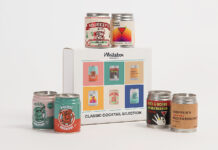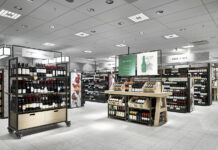Dave Phinney didn’t know what to expect when he knocked on the door of a cottage tucked into the hills of California’s Sonoma County.
Phinney, one of the most renowned wine innovators on the West Coast, was totally hungover as a friend in real estate brought him to survey the rolling acres of property that sprawled beyond the house. The two men knocked on the front door. When it opened, Phinney was staring at Jeffery Butts, a shirtless Vietnam vet with a wide-brimmed camouflage hat and a pistol readied in his holster. Minutes later, Phinney was bear-hugging Butts on the back of a four-wheeler as they tore through a golden, heat-seared span of the Alexander Valley.
When Phinney climbed off, he got his legs back enough to realize the property had a sparkling, natural spring on it. A bleary-eyed Phinney made Butts an offer. The vet accepted with a firm handshake. But if California’s culinary world thought that Phinney would use this acquisition for yet another wine triumph, it was about to get a curveball.
Phinney didn’t plant a vineyard on the land. Instead, he set his sights on that pure, translucent water.
Now, he and longtime distiller Jordan Via are using that spouting bounty from earth for whiskeys that take the state’s farm-to-fork legacy into uncharted territory. Their company, Savage & Cooke, is creating spirits with corn, barley and rye sourced from one local farm and Phinney’s mineral-rich water spilling from the Alexander Valley. It’s a process they have perfected with an element of California’s sun-touched vino virtue, finishing each batch in one of Phinney’s wine barrels in order to get the closest thing they can to a genuine Golden State bourbon.
Whiskey fans are taking notice, but they’re also noticing that Phinney and Via are chasing this audacious dream inside the husk of a World War II-era naval shipyard with its own place in the history of great moments in California.
Phinney grabbed the wine industry’s attention when he was just 24 by founding Orin Swift Cellars. The Napa County mainstay attracted a legion of fans with its savvy combination of bold vintages, captivating labels and affordable prices. Phinney eventually became a national name by releasing The Prisoner, a spicy, zin-heavy red blend that was a blockbuster on store shelves. He later sold The Prisoner to Huneeus Vintners and Orin Swift to E. & J. Gallo.
Phinney got his appreciation for spirits from his father, a steadfast single malt Scotch fan. Yet whenever distributors urged him to get into the whiskey game because of how profitable it was, the wine maverick always brushed them off.
“If you know me at all, I don’t ever do anything with that in mind,” Phinney says. “I was raised to believe that, if you work hard, the money will come.”
It wasn’t until Phinney acquired his exclusive spring water that he seriously began to contemplate bringing something new to the landscape of spirits. But he needed the right distiller to do it.
In a way, Via was a natural fit to fill that role. Like Phinney, he’d started out as a California winemaker. Then an apprenticeship with Stillwater Spirits altered his course.
“It definitely spoke more to the chemist in me,” Via recalls. “It was repeatable results. And unlike wine, you weren’t so reliant on what nature gave you every year.”
Via eventually got obsessed with spirit making. After honing his craft, he helped found Breckenridge Distillery on the snow-capped, alpine summits of Colorado. Via’s high-rye mash American-style whiskey fueled Breckenridge’s popularity as the “World’s Highest Distillery.” He’s since worked on other projects, including a New York Old Tom gin called Queen’s Courage and Bob Dylan’s own signature series of whiskeys, Heaven’s Door.
Via was happy to be Savage & Cooke’s master distiller. He may not have been surprised that California’s youngest wine prodigy wanted to venture into spirits, but he was very surprised about where Phinney wanted to do it: Mare Island sits between the Napa River and San Pablo Bay in the waters north of San Francisco. Its shipyard marks the oldest US naval base on the West Coast—and the building and repairing hub that spurred victory in the Pacific during World War II. One of Phinney’s companies purchased the whole south block of the naval base. It was here, inside a century-old red brick behemoth, that he planned to locate his distillery and tasting room.
“Dave had this vision, and I thought he was crazy,” Via admits with a laugh. “I’m glad he didn’t listen to me because this place is beautiful.”
After a full renovation, the Savage & Cooke Distillery opened in 2018. Whether driving to the island hideaway from Napa’s wineries or taking a ferry from San Francisco, visitors get to taste what’s coming out of its Vendome Copper & Brass Works column still while being surrounded by the shipyard’s industrial maritime charm.
Phinney and Via get all their ingredients, including an heirloom variety of Bloody Butcher corn, from a single farm that’s 40 miles away on the edge of the Vaca Mountains. Once the barley is harvested, it’s sent to a small custom malthouse in nearby San Francisco. The duo has a master cooper from the Bay Area design and make their barrels, too. After the whiskeys are aged — three years for the rye, four years for the bourbon — they’re finished for 45 to 60 days in Phinney’s wine barrels. The distillery’s American whiskey is a high-corn recipe finished in Zinfandel barrels; its bourbon is finished in Napa County Cabernet Sauvignon barrels, and its flagship straight rye whiskey is finished in Grenache barrels from a vineyard that Phinney owns in France.
“It’s pretty amazing to have control all the way back to the beginning of this process,” Via stresses. “I couldn’t point to another whiskey out there that finishes in table wine barrels or dry wine barrels, and it’s because it’s a very tricky dance to not let it go too far, especially with some of the more aggressive barrels, like the Cabernet. But all these things, without rendering the whiskey indistinguishable from its category, just elevate a bit and compliment it.”
Via adds, “And here, I am most assuredly making a California whiskey.”
Phinney agrees, noting that Savage & Cooke’s sourcing, its partners, its process and its location amount to an all-in commitment to the California dream.
“It’s a big bet,” Phinney says, glancing at the towering iron supports from what’s left of the shipyard’s gantry cranes. “But I don’t ever want to look over my shoulder wondering what might have been.”











